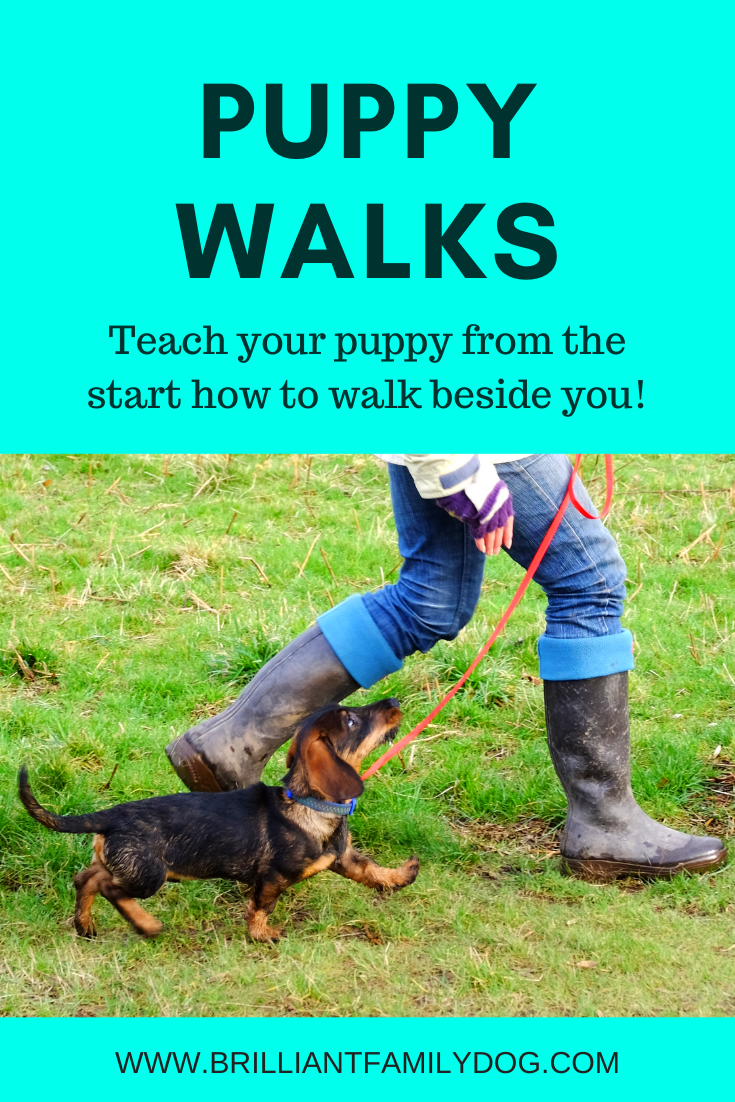This is a GREAT question! And there are lots of things for you to consider.
Here’s some generally-accepted wisdom, but the devil is in the detail! Take these guidelines with a b-i-i-i-i-g pinch of salt.
A general guide for exercising puppies is to allow them one to two sessions of five minutes walking for each month of age, so for example, a four month old pup could enjoy walks of 20 minutes at a time, once or twice a day. Blue Cross
The UK Kennel Club actually gives suggested walk duration for adults of all the different dog breeds here: https://www.thekennelclub.org.uk/search/breeds-a-to-z/, though I would certainly argue with some of their recommendations!
What kind of puppy do you have?
There are large breed puppies, toy puppies, highly active puppies, working breeds you plan to work, and working breeds you don’t want to work.
All puppies need care taken of their joints. And this is essential for the large, slow-maturing, breeds. The growth plates don’t close in the joints till maturity, and this can be as late as 2 years old for larger dogs.
And of course your tiny Chihuahua doesn’t want the legs run off him.
All puppies should be lifted in and out of the car to start with, and larger breed puppies will need a step to climb in and out of the car safely when they’re too big for you to lift.
Lead walking vs free running
There is a huge difference between tramping the streets on a lead, and free running and playing on a suitable surface.
I would limit hard-surface walks for your puppy - pavement, road, hard-baked and frozen ground - to as little as possible. Keep him on soft, grassy, surfaces, and avoid slippery surfaces like the plague.
You also have to consider your puppy’s type - coat, length of muzzle, paw-shape - and check the weather, especially when it’s hot.
Whether it’s a roadwalk or free play, all the time your puppy is learning, so all the time you need to be teaching!
Don’t expect your puppy to KNOW how to walk on lead! We have to teach him. Walking nicely beside you on lead does not come installed. It’s an add-on.
Start as you mean to go on, with non-aversive equipment, like a harness and medium-length lead rather than a collar - and never use an extendable lead, which just teaches your dog to pull, leaving you with more work to do later when your little scrap is a hefty beast able to haul you along and pull you over!
Follow a good, kind, loose lead walking program and teach your puppy in the house before expecting him to have any understanding when he’s in the thick of it - sights, sounds, and smells bombarding him on all sides.
Exploring and socialisation for your puppy
Right now what he needs is mental stimulation, and free exercise: playing with you in the garden, running, jumping, rolling over … Any roadwalks are purely for exploration, not route-marches!
Take care if you have older dogs though. Most older dogs are kind and will adapt their play to a young puppy. But if you’re out and about and there are dogs racing around, don’t let your puppy join in! There’s a high chance of him overdoing it, or annoying the older dogs.
Playing with a similar size, age, breed or type, of puppy can be very helpful. Puppy-puppy play is another of those areas where you need some knowledge before jumping in, so be sure you’re getting tuition from a qualified professional force-free trainer on this tricky subject. There can be serious fallout from unregulated puppy play.
Who is the walk for?
And always keep in mind who this walk is for! You may have got a dog because you want to keep fit and get out and about, but you’ll have to wait for your puppy to develop before you can start tramping over moor and mountain.
For a puppy, walks are for exploring and socialising - discovering the world and all that’s in it in a way that doesn’t make him afraid. Always allow him to check things out at a distance, rather than dragging him over to meet people or other dogs.
Consistency is key
It’s better to have regular small amounts of exercise to develop the strength in those bones and muscles, rather than a huge long tramp at the weekend and very little the rest of the time.
If you are planning on employing a dog walker - be sure that they are professionally qualified and know what’s right for a puppy. Quiz them thoroughly. Damage done now can result in costly pain and vet bills later on.
Remember that swimming, paddling, and climbing stairs or logs, managing new surfaces (large gravel, pea gravel, mud, forest floor) - all coming under the general heading of Puppy Gym - and learning simple tricks, are also exercise!
Do I really have to wait?
Yes. You do. This time of limited and carefully-guided exercise will pass soon enough, as you and your puppy learn new skills together to fit you for your long life ahead.
And you’ll be rewarded with a more contented, healthier dog for the rest of his days.
Want more help for your new puppy? We’d love to show you more!
Watch our free Workshop on Getting your Dog to LISTEN, here


